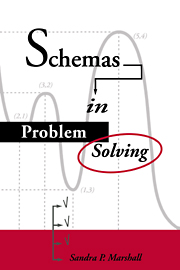Book contents
- Frontmatter
- Contents
- Preface
- Acknowledgments
- I Fundamentals
- II Schemas and instruction
- III Learning from instruction
- 6 Learning and schema theory
- 7 Learning from schema-based instruction
- 8 The acquisition of planning knowledge
- 9 The diagram: Marker and template
- IV Schemas and assessment
- V Schema models
- Notes
- References
- Name index
- Subject index
8 - The acquisition of planning knowledge
Published online by Cambridge University Press: 22 October 2009
- Frontmatter
- Contents
- Preface
- Acknowledgments
- I Fundamentals
- II Schemas and instruction
- III Learning from instruction
- 6 Learning and schema theory
- 7 Learning from schema-based instruction
- 8 The acquisition of planning knowledge
- 9 The diagram: Marker and template
- IV Schemas and assessment
- V Schema models
- Notes
- References
- Name index
- Subject index
Summary
Two studies have incorporated the use of the Problem Solving Environment (PSE) in their design. One was the second experiment of chapter 7, which contrasted learning from abstract and specific instruction. As the final part of that study, one group of students worked for one session with PSE while another group completed the original SPS instruction. The essential conclusion we drew from the study was that 1 hour was simply too brief a time for the students to become comfortable in the interactive environment. They were able to use PSE but not as freely as we had hoped, and we suspected that their freedom to develop their own plans for problem solving was hampered by a lack of familiarity with the computer system itself.
We did gain some information about how valuable PSE could be with pairs of students, because some of the students using PSE worked together as part of the experimental design and their conversations were audiotaped. PSE seems to be an ideal setting for the interaction of pairs or small groups. They can describe their plans to each other in terms of the diagrams and icons, which are always visible on the screen, and they can try out their ideas with no ill consequences. The computer display is large enough to accommodate several students easily, so all of them have clear visual access.
- Type
- Chapter
- Information
- Schemas in Problem Solving , pp. 215 - 235Publisher: Cambridge University PressPrint publication year: 1995



